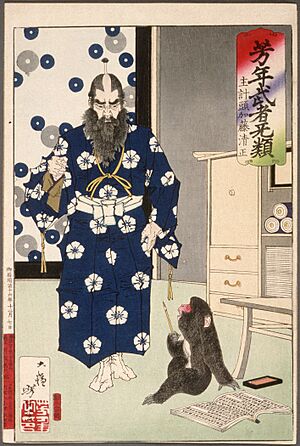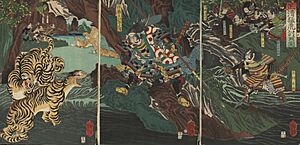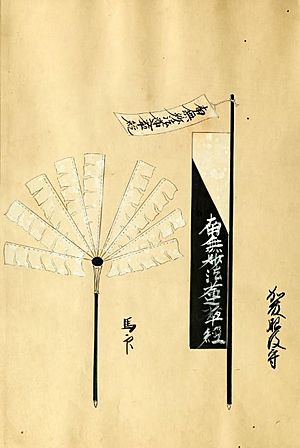Katō Kiyomasa facts for kids
Quick facts for kids
Katō Kiyomasa
|
|||||
|---|---|---|---|---|---|
| 加藤 清正 | |||||

Portrait of Katō Kiyomasa
|
|||||
| Lord of Kumamoto | |||||
| In office 1587–1611 |
|||||
| Succeeded by | Katō Tadahiro | ||||
| Personal details | |||||
| Born |
Toranosuke
July 25, 1562 Owari Province, Japan |
||||
| Died | August 2, 1611 (aged 49) Kumamoto, Japan |
||||
| Spouse | Shōjō-in | ||||
| Children | Yōrin-in | ||||
| Religion | Nichiren Buddhism | ||||
| Military service | |||||
| Allegiance | |||||
| Unit | |||||
| Commands | Kumamoto Castle | ||||
| Battles/wars | Siege of Tottori Siege of Takamatsu Battle of Yamazaki Battle of Shizugatake Battle of Komaki and Nagakute Kyūshū campaign Korean Campaign Siege of Udo Siege of Yanagawa |
||||
| Japanese name | |||||
| Kanji | 加藤 清正 | ||||
| Hiragana | かとう きよまさ | ||||
|
|||||
Katō Kiyomasa (加藤 清正, July 25, 1562 – August 2, 1611) was a famous Japanese daimyō (a powerful feudal lord). He lived during the Azuchi-Momoyama and Edo periods of Japan. His special court title was Higo-no-kami. As a child, he was known as Yashamaru or Toranosuke. He was one of the brave warriors called the Seven Spears of Shizugatake, who served Toyotomi Hideyoshi.
Contents
Early Life and Rise to Power
Katō Kiyomasa was born in what is now Nakamura-ku, Nagoya, Japan. His father was Katō Kiyotada. Kiyomasa's mother, Ito, was a cousin of the powerful leader Toyotomi Hideyoshi. Kiyomasa's father died when he was very young.
After his father's death, young Kiyomasa, then known as Toranosuke, began working for Hideyoshi. In 1576, when he was 15, he started receiving a payment of 170 koku (a measure of rice, used to show wealth).
Becoming a Brave Warrior
Kiyomasa fought in Hideyoshi's army at the Battle of Yamazaki in 1582. He also fought bravely in the Battle of Shizugatake in 1583. Because of his courage in this battle, he became known as one of the Seven Spears of Shizugatake. He was rewarded with an extra 3,000 koku for his efforts.
In 1584, Kiyomasa joined the Battle of Komaki and Nagakute. This battle was against the powerful Tokugawa clan.
When Hideyoshi became the kampaku (a top government official) in 1585, Kiyomasa received an important court title. He was named Kazue no Kami, which meant he was the head of the accounting bureau.
Lord of Kumamoto Castle
In 1587, Kiyomasa fought in the Kyūshū campaign against the Shimazu clan. After this, a large area of land in Higo Province was given to him. This land was worth 250,000 koku. He was also given Kumamoto Castle as his main home in the province.
Adventures in Korea
Kiyomasa was one of the main commanders during the Seven-Year War (1592–1598) against Korea. He worked with Konishi Yukinaga to capture important cities like Seoul and Busan. He also defeated the last of the Korean regular soldiers at the Battle of Imjin River.
The Korean king, Seonjo of Joseon, left Seoul before Kiyomasa's army arrived. Kiyomasa took two Korean princes as hostages. He used them to make lower-ranking Korean officials surrender. During the war, Kiyomasa was known for hunting tigers for sport. He used a yari (a type of spear) and later gave the tiger skins to Hideyoshi. Some stories say he tried to catch tigers alive to bring their meat to Hideyoshi, hoping it would make his lord healthier.
Building Castles and Famous Battles
Kiyomasa was also famous for building strong castles. During the war in Korea, he built several Japanese-style castles in the areas he took over. Ulsan Castle was one of these fortresses. It was the site of Kiyomasa's most famous battle, the Siege of Ulsan, on December 22, 1597.
Kiyomasa bravely led the defense of Ulsan Castle. He successfully held off a large Chinese army of 60,000 soldiers. He defended the castle until November 23, 1598. However, his bravery was not fully reported to Hideyoshi by his rival, Ishida Mitsunari. Because of this, Hideyoshi called Kiyomasa back to Kyōto.
Like many other lords who fought in Korea, Kiyomasa brought a group of Korean potters back to his land in Kyūshū.
The Sekigahara Campaign
After Toyotomi Hideyoshi died in 1598, there was a big disagreement among Japan's military leaders. Seven generals, including Kiyomasa, had issues with Ishida Mitsunari. They felt Mitsunari had not fairly reported their achievements during the war in Korea.
Choosing Sides
This disagreement was not just a personal problem. It was part of a larger rivalry between the supporters of Tokugawa Ieyasu and those who opposed him, led by Mitsunari. Because of this, many military leaders who had problems with Mitsunari later supported Ieyasu.
Kiyomasa was a loyal follower of the Toyotomi family. However, he decided to support Tokugawa Ieyasu. There were two main reasons for this. First, the Western forces were led by Ishida Mitsunari, whom Kiyomasa strongly disliked. They had argued during the Korean campaign. Second, the Western forces included Konishi Yukinaga. Even though Konishi's navy had helped Kiyomasa at the Siege of Ulsan, the two men did not get along.
Kiyomasa joined Tokugawa's side. During the Sekigahara campaign (August–October 1600), he fought against Ishida's allies on Kyushu. He captured several of Konishi's castles. He was getting ready to invade the Shimazu area when the campaign ended. Ieyasu then told him to stop fighting. For his help, Kiyomasa was given the other half of Higo Province. This land had belonged to Konishi, who was executed after Sekigahara. This made Kiyomasa's total income nearly 500,000 koku.
Later Life and Legacy
In his later years, Kiyomasa tried to help settle the growing tension between Ieyasu and Toyotomi Hideyori. In 1611, after one such meeting, he became ill on his way back to Kumamoto by sea. He died shortly after arriving home.
Kiyomasa was buried at Honmyō-ji temple in Kumamoto. He also has graves in other parts of Japan, including Yamagata Prefecture and Tokyo. Kiyomasa is honored in many Shinto shrines across Japan, such as Katō Shrine in Kumamoto.
His son, Katō Tadahiro, took over as the lord of Higo. However, Tadahiro's land was taken away in 1632 by Tokugawa Iemitsu. This happened because he was suspected of planning against Iemitsu.
Personality and Beliefs

Kiyomasa was a very strong follower of Nichiren Buddhism. He encouraged the building of Nichiren temples in his lands. He often disagreed with Konishi Yukinaga, who ruled the other half of Higo province and was a Christian. Kiyomasa was known for being very strict with Christians in his territory.
Historians describe Katō Kiyomasa as a military man first and foremost. He believed that martial arts were the most important thing. His rules for his warriors showed his strong and simple way of thinking. They emphasized that a warrior's main duty was to be ready to fight and even die for their lord.
Family Life
Kiyomasa married Shōjō-in, who was the daughter of Mizuno Tadashige. Before their marriage, she was adopted by Tokugawa Ieyasu. Their daughter, Yōrin-in, later married Tokugawa Ieyasu's tenth son, Tokugawa Yorinobu.
Honors
In 1910, Kiyomasa was given a special honor after his death. He was promoted to junior 3rd court rank (jusanmi).
See also
- Katō Yoshiaki
- Battle of Sendaigawa




